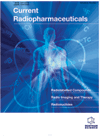- Home
- A-Z Publications
- Current Radiopharmaceuticals
- Previous Issues
- Volume 15, Issue 2, 2022
Current Radiopharmaceuticals - Volume 15, Issue 2, 2022
Volume 15, Issue 2, 2022
-
-
Potential Utility of Radiopharmaceuticals in the Battle Against SARSCov- 2 and COVID-19 Pandemic
More LessAuthors: Omer Sager, Ferrat Dincoglan, Selcuk Demiral and Murat BeyzadeogluCoronavirus disease 2019 (COVID-19) pandemic, which has emerged in December 2019 in the city of Wuhan, China, has significantly affected healthcare systems and economies within a short timeframe. Treatment strategies offer alleviation of symptoms in the absence of commercially available specific antiviral agents. Within this context, the introduction of innovative therapeutic approaches against the SARS-CoV-2 viru Read More
-
-
-
Synthesis of 225Ac-PSMA-617 for Preclinical Use
More LessBackground: The recent approval of radiopharmaceuticals for diagnosis and treatment of cancer is ushering nuclear medicine into a new era of theranostics and alpha therapy using radiopharmaceuticals labeled with 225Ac shows remarkable results in clinical trials. As such, reliable methods for the synthesis and quality control of 225Ac-radiopharmaceuticals are needed. Objective: 225Ac-PSMA-617 is being used for targeted Read More
-
-
-
Media Fill Test for Validation of Non-Radioactive Kit for Radiopharmaceutical Preparations
More LessIntroduction: The administration of improperly prepared intravenous fluids might determine healthcare-associated infections. Quality and sterility assurance in radiopharmaceutical manufacturing products must be evaluated by media fill tests that simulate the performance of the aseptic manufacturing procedure. The aim of this study is to show a methodological modification of a specific step of media fill tests, giving an o Read More
-
-
-
Ferulago angulata as a Good Radioprotector Against Genotoxicity
More LessIntroduction: Natural products can be used as radioprotector agents because of containing phenolic compounds and several flavonoids with antioxidant properties. When the normal cells are exposed to ionizing radiation, they generate free radicals and reactive oxygen species that can cause damage in DNA, which leads to cellular dysfunction or even cell death. However, it is necessary to identify new radioprotective ag Read More
-
-
-
Assessment Relation of Myocardial Detector Counts and Administered Activity of 99mTc-SestaMIBI in MPI: The Effects of Body Weight, BMI, and Gender
More LessIntroduction: In myocardial perfusion imaging, reducing the number of photons in images of obese patients causes poor image quality. To solve this problem, we need to inject the tracer according to the patients' weight. Therefore, this study aimed to investigate the relationship between myocardial photon counts with patients' weight, BMI, and gender. Materials and Methods: A total of 129 patients underwent myocardial Read More
-
-
-
Toxicity and Tolerability of 177Lu-DOTA-TATE PRRT with a Modified Administered Activity Protocol in NETs of Variable Origin – A Phase 2 Registry Study
More LessBackground: Peptide receptor radionuclide therapy (PRRT) has been recently approved for advanced, metastatic, or progressive neuroendocrine tumors (NETs). Objective: This study reports the adverse events (AEs) observed with patient-tailored administered activity. Methods: Fifty-two PRRT naive patients were treated with 177Lu-DOTATATE. The administered activity ranges between 2.78 and 5.55 GBq/cycle using the patient' Read More
-
-
-
Radioprotective Effect of Febuxostat Against Testicular Damage Induced by Ionizing Radiation in Mice
More LessBackground: The testis is one of the most radiosensitive tissues in pelvic radiotherapy, especially in prostate cancer. Febuxostat (FBX), as an inhibitor of xanthine oxidase, has anti-inflammatory, antioxidant, and anti-apoptosis properties. Objectives: The aim of this research was to survey the protective effect of FBX against irradiation (IR)-induced testis damage via the attenuation of oxidative stress. Methods: Male adult mi Read More
-
-
-
The Alleviating Effect of Herniarin Against Ionizing Radiation-Induced Genotoxicity and Cytotoxicity in Human Peripheral Blood Lymphocytes
More LessBackground and Objective: Herniarin is a simple coumarin that is found naturally in some plant species. In this study, we aimed to evaluate the protective effect of herniarin against ionizing radiation-induced genotoxicity and cytotoxicity in human peripheral blood lymphocytes. Methods: Herniarin was added to human lymphocytes before irradiation with a dose of 2 Gy of Xrays. The antagonistic potential of herniarin again Read More
-
-
-
Assessment of Cell Cytotoxicity and Comet Assay on HER2/neu Positive Cell Line Due to 111In Auger Electrons as DNA-Targeting Radioimmunoconjugate
More LessBackground: Breast cancer Auger electron therapy is a growing field of study in radioimmunotherapy and oncology research. Trastuzumab, a high affinity-binding monoclonal antibody against HER2/neu is which is over-expressed in breast tumors, is used in radiopharmaceutical development. Objectives: In this work, the lethal effects of 111In3+, 111In-DTPA-trastuzumab and 111In-trastuzumab coupled-nuclear localizing seque Read More
-
-
-
Preclinical Investigation of Radiopharmaceuticals: An Accurate and Multidisciplinary Approach
More LessAuthors: Nicoletta Urbano, Manuel Scimeca, Elena Bonanno and Orazio SchillaciBackground: The development of less expensive and pivotal methodologies capable of supporting the researchers in the radiopharmaceutical pre-clinical investigations could provide a crucial incentive for conducting biomedical research involved in the realization of tailored target therapies. Objective: The aim of this pilot study was to evaluate the capability of a digital autoradiography system equipped with a laser scanning d Read More
-
-
-
Comparison of Two Types of Amino Acid Solutions on 177Lu-Dotatate Pharmacokinetics and Pharmacodynamics in Patients with Metastatic Gastroenteropancreatic Neuroendocrine Tumors
More LessAuthors: Marie Lambert, Lawrence Dierickx, Séverine Brillouet, Frédéric Courbon and Etienne ChatelutBackground: 177Lu-Dotatate is used in the treatment of somatostatin-receptor-positive inoperable progressive gastroenteropancreatic neuroendocrine tumors. A co-infusion of amino acids (AAs) is administered to prevent renal toxicity. Objective: This study aimed to quantify the impact of two types of AA cocktails on the pharmacokinetics and toxicity of 177Lu-Dotatate. Methods: Four injections of 7400 MBq 177L Read More
-
Volumes & issues
Most Read This Month
Article
content/journals/crp
Journal
10
5
false
en


